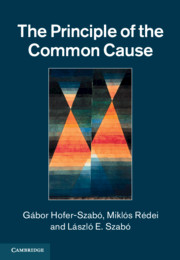Book contents
- Frontmatter
- Contents
- Preface
- 1 Introduction and overview
- 2 The Common Cause Principle
- 3 Common cause extendability of probability spaces
- 4 Causally closed probability theories
- 5 Common common causes
- 6 Common cause extendability of nonclassical probability spaces
- 7 Reichenbachian common cause systems
- 8 Causal closedness of quantum field theory
- 9 Reichenbach's Common Cause Principle and EPR correlations
- 10 Where do we stand?
- Appendix
- References
- Index
3 - Common cause extendability of probability spaces
Published online by Cambridge University Press: 05 June 2013
- Frontmatter
- Contents
- Preface
- 1 Introduction and overview
- 2 The Common Cause Principle
- 3 Common cause extendability of probability spaces
- 4 Causally closed probability theories
- 5 Common common causes
- 6 Common cause extendability of nonclassical probability spaces
- 7 Reichenbachian common cause systems
- 8 Causal closedness of quantum field theory
- 9 Reichenbach's Common Cause Principle and EPR correlations
- 10 Where do we stand?
- Appendix
- References
- Index
Summary
Common cause (in)completeness and extendability
In principle, there are two ways to interpret Reichenbach's Common Cause Principle in general, each determined by how one views the status of the Principle with respect to the conditions of its validity: the Principle can be viewed as a falsifiable or a nonfalsifiable principle. In the falsificationist interpretation, the Common Cause Principle is a claim that can possibly and conclusively be shown not to hold for some empirically given events and their correlations; in the nonfalsificationaist interpretation, the Common Cause Principle cannot be falsified conclusively – whatever the actual circumstances. Is the Common Cause Principle falsifiable or nonfalsifiable?
We shall argue that the Common Cause Principle, as formulated in Chapter 2, is not falsifiable conclusively, but the argument cannot be trivial, since the Common Cause Principle is certainly not trivially nonfalsifiable: it is not true that every classical probability space (X, S, p) is provably common cause complete in the sense that for any A, B ϵ S that are correlated in p there exists a C ϵ S that is a (proper) common cause of the correlation between A and B. There exists common cause incomplete probability spaces (for instance the probability space described in Figure 3.1 is common cause incomplete). This makes the following definition nonempty:
Definition 3.1 The probability space (X, S, p)is common cause incomplete if there exist events A, B ϵ S such that Corrp(A, B) > 0 but S does not contain a common cause of the correlation Corrp(A, B).
- Type
- Chapter
- Information
- The Principle of the Common Cause , pp. 18 - 28Publisher: Cambridge University PressPrint publication year: 2013



